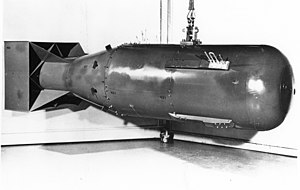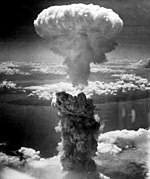小男孩原子彈
body.skin-minerva .mw-parser-output table.infobox caption{text-align:center}
| 小男孩原子弹 | |
|---|---|
 小男孩原子弹的外貌 | |
| 类型 | 原子弹(核武器) |
| 原产地 | 美國 |
| 服役记录 | |
| 服役期间 | 1945年 |
| 使用方 | 美国 |
| 参与战争 | 第二次世界大战(广岛市原子弹爆炸) |
| 基本规格 | |
| 重量 | 4000公斤 |
| 长度 | 3米 |
小男孩(英语:Little Boy)是第二次世界大戰時美國在日本廣島市投擲的首枚原子彈的代號。於1945年8月6日由保羅·提貝茲駕駛的B-29超級空中堡壘轟炸機「艾諾拉·蓋」在廣島相生橋上空31,000英尺(9,400米)投下,日本標準時間早上8時15分在1,800英尺(550米)高度爆炸。
目录
1 簡介
2 相關條目
3 注释
4 参考
5 外部链接
簡介

小男孩在廣島上空引爆,產生巨大的蕈狀雲

以傳統炸藥把環狀鈾(子彈)射向圓柱狀鈾,引發核連鎖反應
「小男孩」是人類歷史上首次對人類使用的核武器,另一枚對人類使用的核武為投擲在長崎的鈈原子彈胖子。小男孩長10英呎(3米),寬28英吋(71厘米),重8,900磅(4,000公斤)。使用「鎗式」設計,將一個富含鈾的空心圓柱體(“子彈”)以炸藥射到相同材料的固體圓柱體(“目標”)上,造成整塊超臨界質量的鈾,引發核子連鎖反應[1][2]。小男孩裝有64公斤的鈾-235[3],其中不到一公斤進行了核分裂[4],釋放的能量約等於13,000公噸的 TNT烈性炸藥,即大概為5.5×1013焦耳。約七萬人直接死於小男孩的原爆,大約同等數量的人受傷。隨後再有大量的人死於核子塵埃放射引起的癌症。懷孕的母親亦因為放射而出現流產,部分初生嬰兒發育畸形。
据統計,直到1999年,死于小男孩原子彈的直接襲擊及核輻射傷害的人數總計已超過20万。
由於時間緊絀而未能提煉足夠濃縮鈾製作試驗彈的情況下,小男孩這種設計的核武器在使用前並未進行過實際試驗。美國於1945年7月16日在新墨西哥沙漠試爆的第一枚原子彈是以鈈為原料。當時美國的濃縮鈾只足以製造一枚鈾核彈。
相關條目
- 曼哈頓計劃
- 胖子原子彈
注释
^ Sublette, Carey. Nuclear Weapons Frequently Asked Questions, Section 8.0: The First Nuclear Weapons. [29 August 2013].
^ Coster-Mullen 2012, pp. 18–19, 27.
^ Coster-Mullen 2012, p. 18.
^ Glasstone & Dolan 1977, p. 12.
参考
Abrahamson, James L.; Carew, Paul H. Vanguard of American Atomic Deterrence. Westport, Connecticut: Praeger. 2002. ISBN 0-275-97819-2. OCLC 49859889.
The Atomic Bombings of Hiroshima and Nagasaki (PDF). The Manhattan Engineer District. 29 Jun 1946 [2013-11-06]. (原始内容 (PDF)存档于6 April 2012). 已忽略未知参数|df=(帮助) This report can also be found here and here.
Bernstein, Jeremy. Nuclear Weapons: What You Need to Know. Cambridge University Press. 2007. ISBN 0-521-88408-X.
Campbell, Richard H. The Silverplate Bombers: A History and Registry of the Enola Gay and Other B-29s Configured to Carry Atomic Bombs. Jefferson, North Carolina: McFarland & Company. 2005. ISBN 0-7864-2139-8. OCLC 58554961.
Coster-Mullen, John. Atom Bombs: The Top Secret Inside Story of Little Boy and Fat Man. Waukesha, Wisconsin: J. Coster-Mullen. 2012. OCLC 298514167.
Diacon, Diane. Residential Housing and Nuclear Attack. London: Croom Helm. 1984. ISBN 978-0-7099-0868-5.
D'Olier, Franklin (编). United States Strategic Bombing Survey, Summary Report (Pacific War). Washington: United States Government Printing Office. 1946 [6 November 2013]. This report can also be found here.
Genetic Effects: Question #7. Radiation Effects Research Foundation. [2013-11-06].
Glasstone, Samuel. The Effects of Nuclear Weapons, Revised Edition. United States: United States Department of Defense and United States Atomic Energy Commission. 1962. ISBN 978-1258793555.
Glasstone, Samuel; Dolan, Philip J. The Effects of Nuclear Weapons, Third Edition. United States: United States Department of Defense and United States Department of Energy. 1977. ISBN 978-1603220163.
Gosling, F. G. The Manhattan Project: Making the Atomic Bomb. Diane Publishing. 1999. ISBN 978-0-7881-7880-1.
Groves, Leslie R. Now it Can Be Told: the Story of the Manhattan Project. New York: Da Capo Press (1975 reprint). 1962. ISBN 0-306-70738-1.
Hansen, Chuck. Volume V: US Nuclear Weapons Histories. Swords of Armageddon: US Nuclear Weapons Development since 1945. Sunnyvale, California: Chuckelea Publications. 1995. ISBN 978-0-9791915-0-3. OCLC 231585284.
Hansen, Chuck. Volume VII: The Development of US Nuclear Weapons. Swords of Armageddon: US Nuclear Weapons Development since 1945. Sunnyvale, California: Chuckelea Publications. 1995a. ISBN 978-0-9791915-7-2. OCLC 231585284.
Hoddeson, Lillian; Henriksen, Paul W.; Meade, Roger A.; Westfall, Catherine L. Critical Assembly: A Technical History of Los Alamos During the Oppenheimer Years, 1943–1945. New York: Cambridge University Press. 1993. ISBN 0-521-44132-3. OCLC 26764320.
Human Shadow Etched in Stone. Photographic Display. Hiroshima Peace Memorial Museum. [2013-11-06].
Izumi S, Koyama K, Soda M, Suyama A. Cancer incidence in children and young adults did not increase relative to parental exposure to atomic bombs. British Journal of Cancer. November 2003, 89 (9): 1709–13. PMC 2394417. PMID 14583774. doi:10.1038/sj.bjc.6601322.
Izumi S, Suyama A, Koyama K. Radiation-related mortality among offspring of atomic bomb survivors: a half-century of follow-up. International Journal of Cancer. November 2003, 107 (2): 292–7. PMID 12949810. doi:10.1002/ijc.11400.
Jones, Vincent. Manhattan: The Army and the Atomic Bomb (PDF). Washington, D.C.: United States Army Center of Military History. 1985 [25 August 2013]. OCLC 10913875.
Malik, John S. The yields of the Hiroshima and Nagasaki nuclear explosions (PDF). Los Alamos National Laboratory report number LA-8819. 1985 [6 November 2013].
Nuclear Weapon Thermal Effects. Special Weapons Primer, Weapons of Mass Destruction. Federation of American Scientists. 1998 [2013-11-05]. (原始内容存档于22 April 2013). 已忽略未知参数|df=(帮助)
Rhodes, Richard. The Making of the Atomic Bomb. New York: Simon & Schuster. 1986. ISBN 0-684-81378-5. OCLC 13793436.
Rhodes, Richard. Dark Sun: The Making of the Hydrogen Bomb. New York: Touchstone. 1995. ISBN 0-684-82414-0.
Richardson, David; 等. Ionizing Radiation and Leukemia Mortality among Japanese Atomic Bomb Survivors, 1950–2000. Radiation Research. September 2009, 172 (3): 368–382. PMID 19708786. doi:10.1667/RR1801.1.
Samuels, David. Atomic John: A truck driver uncovers secrets about the first nuclear bombs. The New Yorker. 15 December 2008 [30 August 2013].
Serber, Robert; Crease, Robert P. Peace & War: Reminiscences of a Life on the Frontiers of Science. New York: Columbia University Press. 1998. ISBN 9780231105460. OCLC 37631186.
外部链接
维基共享资源中相关的多媒体资源:小男孩原子彈 |
Little Boy description at Carey Sublette's NuclearWeaponArchive.org
| ||||||||||||||||||||||||||||||||||||||
